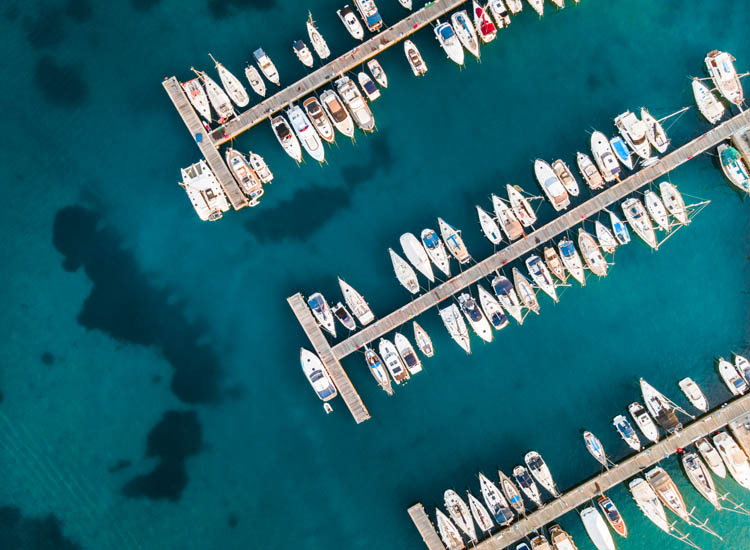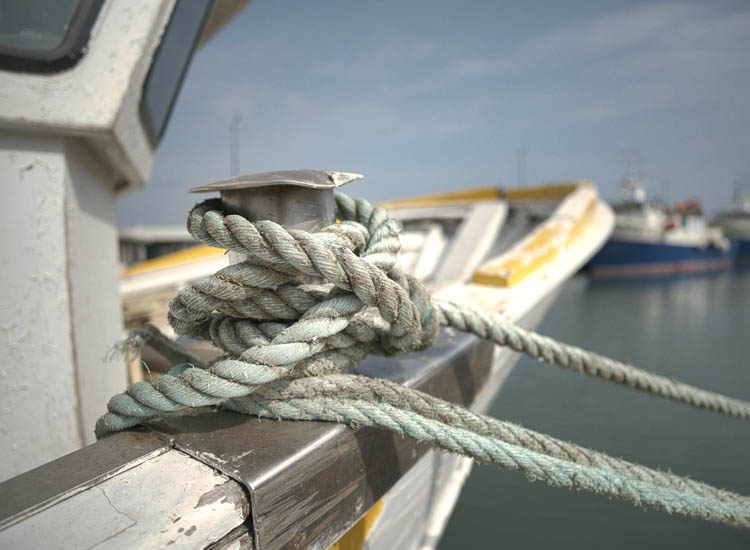Seneca said that “There is no favourable wind for those who do not know where they are going”.
This quote, which refers to the need to have a plan, is applicable to almost every aspect of life. And it couldn’t be truer if you are thinking of booking moorings and buoys in Mallorca and the Balearic Islands.
It is essential to have the itinerary we want to follow well organised, to know where we are going to anchor during the day and at night.
So if you’re thinking of taking a boat trip to the Balearic Islands, read on because we bring you all the information you need to book moorings and buoys in Mallorca and the other islands of the archipelago.
Let’s get started!
Types of ports on the Balearic Islands
Due to their insular nature, the ports in the Balearic Islands are very important.
There are ports under the jurisdiction of the State and others that depend on the autonomous community.
The state-run ports are: the ports of Palma, Alcúdia, Ibiza, Mahón and La Savina.
The autonomous ports are managed by Ports de les Illes Balears (for example, the Port of Sant Antoni de Portmany in Ibiza, the ports of Ciutadella and Fornells in Menorca or the ports of Colonia de Sant Jordi, Sóller or the Club de Vela del Port d’Andratx).
There are also ports that are operated through concessions. The port concessionaires can cede temporary rights of use for mooring to third parties by means of a contract that is of a private nature and only affects these two parties.
- Commercial ports. Commercial port activities, such as stevedoring, unstowing, loading, unloading, transhipment and storage of goods of any kind, as well as passenger traffic, are carried out in these ports.
- Fishing ports. Ports used for unloading fresh fish and for sheltering vessels in the event of a storm, provided that no sales take place there.
- Marinas. Designed for use by sporting or recreational vessels.
Types of moorings and buoys
Let’s start by defining what a mooring is in nautical terms: It is a device or system used to secure a boat to prevent it from drifting away from the desired location. It consists of a permanent anchor and a mooring buoy, which is connected to the anchor by a chain or rope.
There are several types of boat moorings, here are the most common ones:
- Dock mooring. This consists of securing the vessel to a floating pontoon. It is one of the most common methods in ports and marinas.
- Buoy mooring This type of mooring involves attaching the vessel to a buoy anchored to the seabed. It is common in bays or protected areas where direct anchoring is not permitted to avoid damage to the seabed.
- Anchoring: Involves the use of an anchor that is placed on the seabed to maintain the boat’s position. There are different types of anchors depending on the seabed (sand, rock, mud) and the type of vessel.
- Dry mooring. This consists of storing the boat out of the water when not in use, either in a shed, on a rack or on a trailer.
- Floating dock mooring. Similar to dock mooring, but using floating platforms that move with the tides and waves, suitable for waters with significant tidal changes.
- Mediterranean mooring. This type of mooring is made from the stern to the quay and is combined with anchors deployed from the bow. It is typical in the Mediterranean region, where space in ports is limited.
- Tandem mooring. This is the securing of two boats together, side by side, often used when there is limited space on the quay.
- Long-term mooring. Designed for extended periods, may include additional measures such as storm protection or reinforced security systems.
- Grid mooring. Specially for high tides, where the vessel is moored to a fixed structure and rests on the seabed at low tide.
Each type of mooring has its own advantages, disadvantages and specific requirements. It is important to choose the right type of mooring to ensure the safety of the boat and the marine environment.
When making your choice, consider the type of boat, the location and the weather conditions. Buoys, on the other hand, are floating beacons placed in a river or in the sea. They are usually anchored to the seabed and serve a variety of purposes, such as orienting vessels and marking submerged objects.
The ones we are interested in in this article are anchoring or mooring buoys, which are designed for boats to moor to. They are a good alternative to anchoring directly to the seabed, thus protecting sensitive habitats.
Booking process for moorings and buoys in Mallorca and the Balearic Islands
The booking process is simple and quick. It can be done online or by phone. What is more complicated is that there is availability because the booking of moorings and buoys in Mallorca and the Balearic Islands is in high demand in high season. The information you need to have at hand to make the reservation is:
- Dates when you need to book the buoy or mooring.
- Dimensions of the boat: length, beam and draught.
- Type of boat: motorboat, llaud, catamaran, sailboat, jet ski…
- Documentation and registration of the boat.
Depending on the marina, there may be a minimum or maximum stay.
There is also the possibility of booking a long-stay buoy.
Remember that each marina may apply different conditions, so the best thing to do is to contact the different marinas and ask if they have mooring for the dates indicated.
For example, in the buoy fields that depend on the Balearic Government it is possible to book a maximum of 2 consecutive nights every 6 calendar days in the same buoy field.
Ports IB is a portal created by the Balearic Government where you can consult and reserve moorings in all the ports of the Balearic Islands. They also have a telephone number to answer any queries you may have.
Responsible tourism: the importance of Posidonia oceanica
If you are a regular reader of our blog, you probably already know that we are in love with the Mediterranean seabed and its Posidonia oceanica meadows.
And that it is the responsibility of all nautical enthusiasts to protect it.
With the aim of minimising threats, the Balearic Government has defined 9 SCI areas (Sites of Community Importance).
These are regulated anchoring areas, where it will be compulsory to anchor in the buoys installed to prevent our anchors from damaging the Posidonia that lives there.
Three anchoring areas have been established
- Free anchorage, where you can drop anchor freely, taking into account safety regulations.
- Anchoring regulated by buoys, where you will find buoys designed for this purpose.
* Red buoys: for boats of less than 8 metres in length.
* White buoys: for boats from 8 to 15 metres in length.
* Yellow buoys: for vessels from 15 to 25 metres in length.
* Green buoys: for vessels from 25 to 35 metres in length. - Restricted anchorage: extensive posidonia meadows where we can only anchor on sandy bottoms.
If you have a reservation at one of these buoys, the surveillance boat will come to check the reservation and give you information about the characteristics of the anchoring area and about the Life Posidonia Project.
Bear in mind that these buoys are for anchoring for a limited period of time, and never as a refuge area in the event of storms.
To learn more about this underwater plant, you can’t miss this post dedicated to it: Sail with a conscience: Protect Posidonia in the Balearic Islands
Frequently asked questions
How much does it cost to rent a boat mooring?
The cost of renting a boat mooring can vary depending on the location, the size of the mooring and the duration of the rental. In general, larger moorings in more popular locations tend to be more expensive.
What size mooring do I need for my boat?
It depends on the size of the boat. Therefore, the length of the boat is required when making a reservation.
What services are included in the rental of a mooring?
It depends on each port. The services included in the rental of a mooring can vary, but they are usually electricity, water and cleaning services. There are ports that provide a complete service with showers and toilets, internet connection, manoeuvring assistance, commercial and gastronomic offer or heliport procedures among many others.
Do I need insurance for my boat if I rent a mooring?
Again, it depends on the marina. It may be compulsory to have liability insurance or the marina may not require it. In any case, if it is not compulsory, it will always be advisable.
Can I live on my boat while it is berthed at the mooring?
In some cases, yes, but this will depend on each port.
Can I reserve a berth in advance?
Yes, in fact it is recommended. As soon as you know the dates and itinerary check for availability.
Are marinas safe?
Many marinas have surveillance systems in place to ensure the protection of boats and their owners. In addition, there are usually restricted entry and exit systems in place.
As a summary, if you are looking for moorings and buoys in Mallorca and the Balearic Islands, these are our tips
- Plan your itinerary in detail.
- Find out more about the types of boats for rent we have available in Mallorca or boat rentals in the Balearic Islands.
- With the information about the boat and the measurements clear, reserve the moorings or buoys.
- Take into account the recommendations to preserve the posidonia seabed.
Now you just have to enjoy your adventure!

